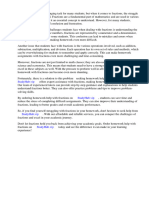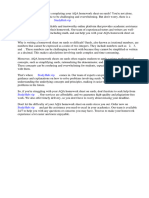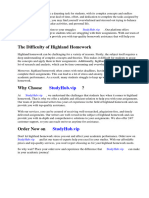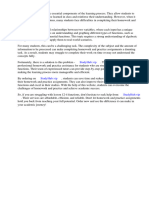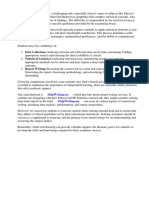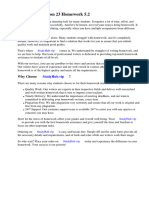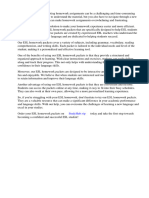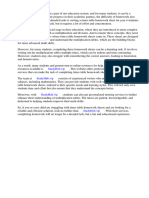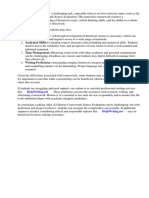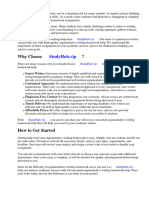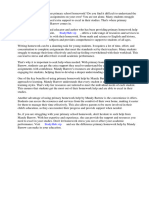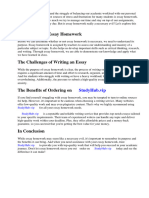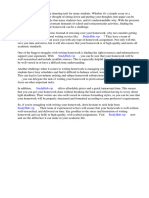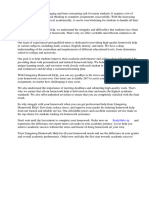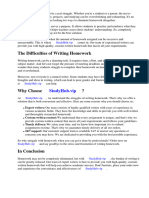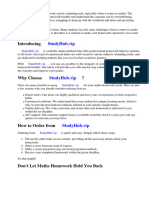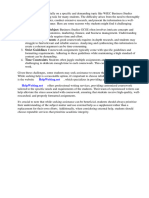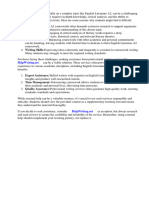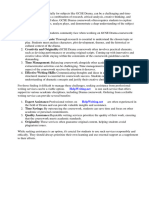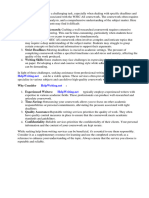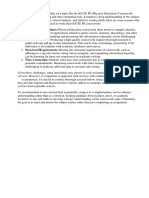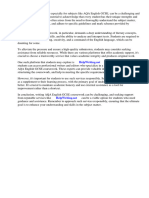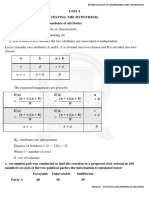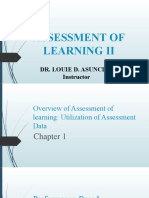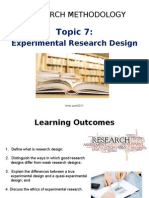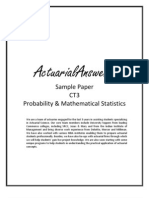Writing a coursework, especially in a challenging subject like Math Statistics, can indeed be a
daunting task. It requires a deep understanding of the subject matter, strong analytical skills, and the
ability to communicate complex ideas effectively. Students often find themselves grappling with
intricate concepts, extensive research, and the pressure of meeting stringent deadlines.
The Math Statistics coursework typically involves collecting, analyzing, and interpreting data, which
can be time-consuming and mentally taxing. Crafting a well-structured and coherent piece requires
not only mathematical prowess but also proficiency in presenting findings through clear and concise
writing. Moreover, the precision required in mathematical notations adds an additional layer of
difficulty.
Considering the challenges involved, seeking assistance can be a wise decision. Platforms like ⇒
HelpWriting.net ⇔ can provide valuable support to students facing difficulties in completing their
coursework. Professional writers with expertise in Math Statistics can offer well-researched and
meticulously crafted content that meets academic standards.
However, it is essential to use such services responsibly and ethically. Ordering coursework assistance
should be seen as a supplementary measure to aid understanding rather than a substitute for personal
learning. Additionally, students must ensure that the service they choose adheres to ethical guidelines
and does not promote academic dishonesty.
In conclusion, writing a Math Statistics coursework can be challenging, and seeking help from
reputable sources like ⇒ HelpWriting.net ⇔ may be a helpful option for those struggling to meet
academic demands. Nevertheless, it's crucial to approach such services responsibly and use them as a
tool for learning rather than a shortcut.
�However 2 boys were away and 1 boy was away for the whole term so you end up with 40 sets of
data. I have done this as boys grow at different times to girls. Alternative hypothesis: There is no
relationship between the ability to estimate the length of a straight line and mathematical ability. 2)
Does the estimation of a non straight line improve after practice. So as the IQ increases, it showed us
that the higher the IQ, the better you’ll do in your SATS; or the higher your Average SATS Score,
the better your IQ will be. I need to make the experiment fair, so I need the same controlled
experiment for each person who does the experiment. It is closest to zero by a long way, meaning on
average they are the most accurate at estimating, although it does have a high standard deviation
perhaps meaning more values are farther away from this mean. This is needed as the mode shows the
most common results, the median shows the middle value when the data is in order and the mean
shows a representative figure for the data you have collected.All these diagrams will either prove or
disprove the first part of my hypothesis - that girls have a higher IQ than boys. I have answered my
hypothesis in fair depth and sighted future tests that could be of interest to this topic. I chose 30 cars
as I will have enough data to make hypotheses, but choosing more than 30 cars would be too much
data to use. Although the lowers band’s data is less consistent, it is less consistent around a value
very close to zero, suggesting many pupils in KS4 lower band guessed very accurately, on a contrary
to my hypothesis. The data which I selected was supposed to be every 6 th person, but some pieces
of data was missing on the sheet, so I had to choose the one below, and start counting every 6 th
person again. However, the data that I will plot on graphs and calculate will include the heights,
weights and ages which are all quantitative data which includes continuous numbers. Firstly it is
noticeable that the majority of the girls' data is at the higher end of the IQ scale whereas the majority
of boys are at the lower end. Although there maybe some problems and anomalies with this sample
because someone maybe away, someone maybe blind or have eye problems and someone might be
handicapped. Most of the points are clustered in that area which tells me that most of the points is
around that mean average. This shows that the Year 11 boy’s have a wider range of interests and are
more open to new things, this makes them more mature than they where in Year 7. Just because the
student is a Year 7 pupil, that doesn’t mean that their attendance figures are going to be really low.
The data I will need to collect are “Year 7’s boys; Year 7 girls; Year 11 boys; Year 11 girls” data. This
is shown from the evidence of KS4 lower band, who seemed to be much more accurate at estimating
even than the upper level KS4. Although there maybe some problems and anomalies with this sample
because someone maybe away, someone maybe blind or have eye problems and someone might be
handicapped. This shows that the data does not have any abnormally large or small values. I think
that the girls would come with good results because they are more intellectually clever at the age of
11 than boys. This also suggests that generally students are more likely to guess lower than the true
value, rather than higher. So this graph was very reliable and very resourceful because it evidently
presented that as the height of the student increases, the weight increases also. To do this I will
calculate the mean, median, mode and range of each set of data and use these values to calculate the
inter-quartile range and the standard deviation to show the spread of the data. Then I will also
analyse all of these graphs and diagrams and actually come to a conclusion that tells me all the
information I need (e.g. which year group have the best attendance figures) for this investigation.
Stratified sampling is used when there is a large amount of data that is needed to be process. I would
also exclude any records with some data not present. Some extensions that I could attempt in the
future include redoing the testing of my hypotheses using much larger samples of data (200 or more)
to build up a more accurate picture of the data, attempting different types of graphs to compare and
show the data (such as cumulative frequency graphs), and using similar methods that I have
portrayed in my investigation above to test other variables from the census (such as height of belly
button). The medians support this further as the girls median is higher than.
�To further, the investigation I would compare the results of younger children to see if that had an
effect on the correlation. If r s is close to zero, the ranks is neither agreeable nor disagreeable. This is
because whilst making the graphs, calculations, analysing and concluding the data, I made sure that
everything that I did was correct and related to my investigation. Average SATS Score shows that
the higher the IQ of a Year 7 Girl, the higher the average SATS Score will be, and the statistic that
supports this is the Spearmans Rank Correlation Coefficient as it is 0.668; and as 1 is the highest and
-1 is the lowest; 0.668 is high as it is close to 1 compared to -1. This would be another factor of why
boys catch up by the time they are in year 9. I would actually expect them to be almost the same in
accuracy, with males perhaps just being slightly more accurate. We can see that in Key Stage 4’s box
plot, there is a positive skew as the median (-1.36) is closer to the upper quartile (2.04). This means
that the majority of the estimates were between -1.36% and 2.04% error with fewer below -1.36,
giving incredibly accurate estimates. It would be unreasonable and difficult for me to use all of the
data given, as it will consume a lot of time during the calculation process. They don’t appear to
change their favourite TV programme choice however; they do appear to diversify slightly with
maturity. At the moment it appears as though the broadsheet uses more of the shorter words than the
tabloid, but this is only the first article and so you can’t tell for sure. This is demonstrated by the
boys' highest score being 9.7% above their median and the girls' highest score being a significantly
larger 24. This scatter graph shows the y dependant on x regression line. However, at the very end,
the frequencies stop, as the graph shows and a straight line is produced. This clearly proves my
hypothesis true about as the person grows older, their height increases. It is used to find the extent to
which two sets of data correlate. My second hypothesis was correct because the boys made a better
improvement then the girls. This will now allow me to create complex graphs to present the data to
enable me to spot any trends, relationships or anomalies in the data for height, weight, year groups,
age and gender. The upper and lower quartiles and the inter-quartile range are used to help me to
construct a box and whisker plot to compare the boys’ and girls’ heights. I will not be including Key
Stage 5 in this part of the investigation as it only has higher band ability, and therefore I cannot
compare this to any other ability of the same age. I did this by highlighting the data I wanted to use
and selecting the new chart button. Consequently, I shall now investigate the other hypotheses
mentioned previously; whether the ability or gender had an effect on accuracy of estimating angles,
and whether this has affected my first hypotheses. By looking at the frequency charts you can see
that the Year 11 boy’s have branched out their choices, they have less people watching cartoons and
soaps and more people watching educational programs and sports. I have hand drawn one scatter
graph, cumulative frequency diagram, box plot, and histogram, so that the reader understands that I
know the method for my calculations. This, coupled with the use of simple, monosyllabic language
shows that they don’t seem to be aiming towards highly educated people, or even the average person
but more towards those with little sense of comprehension and those who may not fully understand
the effects that politics and global news may have on their own lives. Also I can use specific makes
of cars to compare how quickly the car price decreases. I will calculate the mean for each year group
and then I will verify this result by finding the median from a cumulative frequency graph. I predict
that children in year 7 will have smaller feet than children in year 11, because as you grow older your
feet become larger. There are more girls in the year than 52 but only 52 girls could do the experiment
as the high wouldn’t allow the test to be carried out in lesson time so the investigation was carried
out at lunch so some girls couldn’t go or didn’t want to go. As someone’s body grows, it the muscles,
bones and fat on the body increases and gets larger. I will use the same exact formulas for the mean,
mode, median, range, inter-quartile range, upper quartile and lower quartile as I calculated above
with the previous stem and leaf plot (both boys’ and girls’ heights).
�I repeated this process for the girls although, I did find that the smaller sample showed an equally
strong positive correlation I took the re-sample just to be sure. I will use quantitive data which
include numbers e.g. IQ and Average SATS score. However, the students’ appreciation of the
importance of their attendance figures does and this is why (in my opinion) the attendance figures
vary between students. Again though there is no clear relationship between each Key Stage (and
therefore age), in fact KS5 females are further from zero than KS4 females. This way, it does not
only reduce the amount of time for me to process the data, it also reduces its quantity. From this, I
found the spearman’s rank correlation between the Year 7 girls and the Year 11 girls and the Year 7
boys and the Year 11 boys. Although, I think year 7's KS2 results will be higher than year 11's as the
tests have become easier over the five years and the teaching has become better too.PlanFirst of all I
will filter my data so that I am only left with data for all the year 11s and all the year 7s. I then wi.
So the next stage will be to compare the IQs of boys and girls to their total KS2 results. I will then
use a technique to see how closely the children (of different ages) choices correlate. This is expected
as there will be a large amount of variation on the improvement as some will be prepared to work
more than others. The results or points were not all close to the line of best fit so this statement is
only a rough guide. However, the accuracy of the data may not be known. I will need to take a
sample from the population, as it’ll be quick as well, instead of using the whole population’s data. I
think this maybe because my sample is not large enough. This is the class interval that contains the
most values. I know this by looking at how spread out the bottom of the curve, which is the standard
deviation. I think the former explanation is the more plausible of the two having studied the charts
and the standard deviations. I thought this would be a good number because it reflects the whole
year group. Null hypothesis: There is a relationship between the ability to estimate the length of a
straight line and mathematical ability. Also I can use specific makes of cars to compare how quickly
the car price decreases. As this graph has no correlation at all, I have used the Year 7 and Year 11
KS2 Results to assess the intelligence of the strata. Null hypothesis: Practice improves the estimate
of a non-straight line. The inter-quartile range is the difference between the upper and lower quartiles
which also tells me the spread of data. However, the differences between the ranges are actually
quite small (only around 5% difference in error between each Key Stage), although this could be due
just to one person guessing poorly. The first word selected was the fifth, the second word the tenth,
the third word the fifteenth and so on. I will not be including Key Stage 5 in this part of the
investigation as it only has higher band ability, and therefore I cannot compare this to any other
ability of the same age. I need to make the experiment fair, so I need the same controlled experiment
for each person who does the experiment. I also plotted some pie charts using Microsoft Excel
Application to show the percentage of student’s choices. The average height for the boys is 1.63m
and the girls’ average height is 1.59m. This is a difference of 4cm which is quite large for an average.
�I will work out the mean and the standard Deviation for both the Girls and the Boys results. Some
of them will have had growth spurts where as others will have that to come. However, at the very
end, the frequencies stop, as the graph shows, but in this diagram there isn’t a straight line being
produced as the maximum value is 6 and the cumulative frequency curve stops at 6. There is a clear
pattern to see when all the standard deviations are shown. The males are negatively skewed; meaning
most of the estimates were between the median (which was close to zero) and 2.04, giving
exceptionally accurate results. However 2 boys were away and 1 boy was away for the whole term
so you end up with 40 sets of data. I created a single value for the KS2 Result by adding the 3
numbers together. This will allow me to create diagrams such as the cumulative frequency polygons
and calculate, for example, the standard deviation much easier and quicker. The rest of the diagrams
and drawings have been completed neatly and accurately by the computer, so there isn’t a huge mess
on the drawings. Due to this change only occurring at the very end of the graph, the medians support
my hypothesis as year 7s median is slightly higher than year 11s. I repeated this process for the girls
although, I did find that the smaller sample showed an equally strong positive correlation I took the
re-sample just to be sure. From this information, I should be able to infer a judgment on some of the
mental changes that take place during this time of children’s development. For all the scatter graphs,
I will construct them by using Microsoft Excel which will allow me to group the data to present
them into scatter graphs. I expect to see that the more able pupils’ improvement is higher up my scale
and closer together because I believe they have improved more than less able pupils and have all
improved around the same amount. This will then help me view those results to graph and interpret
on to make conclusions on my hypotheses. Increasing the sample size would give a much better
representation of the population. This shows that the overall attendance for the particular academic
year is very good. The means are probably the most surprising statistic in this set of data, as shown.
The median for the male set of data is 165, and for the female set of data it is 163. Average SATS
Score shows that the higher the IQ of a Year 11 Girl, the higher the average SATS Score will be. I
will take the number of people, divided by Total number of people at the school, times by the sample
size. e.g. Also, during the ranking, I will be able to see clearly whether my hypothesis regarding the
important relations between attendance and the exam is true or not. Here is the results from
estimating the straight line. So, the calculator will not give you figures bigger or higher than the
maximum number entered. It is my belief that the newspapers would have filled their quota of
necessary news to report, and then will be focusing on what they individually specialise in. We have
seen no clear relationship between age and accuracy of estimation, nor between the seemingly most
obvious relationship between maths ability and accuracy of estimation. From this graph I have also
noticed one or more of the year 11s scored higher than any of the year 7s. The Daily Mail and the
Daily Star both respectively have 21% and 32% of their papers devoted to celebrity and personal
news, in addition to the fact that overall, the Independent has 35% of its newspaper containing
Global Issues in comparison to 1% of personal stories. Each set is listed alphabetically in the Sims
database. They don’t appear to change their favourite TV programme choice however; they do
appear to diversify slightly with maturity.
�With this, I expect there to be more extreme data from year 7 than year 11. Then I will be able to see
both the mean of the girls and the boys and compare them. By looking at the frequency charts you
can see that the Year 11 boy’s have branched out their choices, they have less people watching
cartoons and soaps and more people watching educational programs and sports. The only explanation
I can give for Key Stage 4’s superior performance is that they may have been learning about
estimating angles more recently so will be in better practise than those studying A level maths, who
may be out of practise due to the lengthy time period since learning to estimate angles. This means
that 0% error will be a perfect estimate, so the higher the percentage error the worse the estimate. It
would be unreasonable and difficult for me to use all of the data given, as it will consume a lot of
time during the calculation process. To work out the means for the raw and grouped data I used the
same methods as in hypothesis 1. A histogram with equal intervals is a frequency diagram (only the
height of the bars vary), however, a histogram with unequal intervals, the area of each bar is
proportional to the frequency of each class and the height of the bars are based on the frequency
density. However, even though it seems like the Year 11 GCSE students tend to come to school
much more often or supposed to attend school everyday than the Year 7s, to me, this doesn’t have
any relations with age at all. This would have made the investigation a great deal more reliable and
accurate to prove or disprove my hypotheses. This is not unexpected however as in the English
language we tend to use shorter length words more often than the longer ones. Key Stage 3 were by
far the least accurate at estimating, which does conform to the hypothesis as they are the youngest.
After this, I will find the median, the upper and lower quartiles and create a “box and whisker” plot.
If I have a chance to do this coursework again, I would like to do it using the full data to make it
more specific and possibly use other graphs and diagrams to display the data. This gives me a total of
90 results which will be used in questions 3 and 4 as well as this one. To take a stratified sample I
will divide the whole population of children into year group and gender e.g. Year 7 Boys. I will then
take 10% of each stratum to gain fair representation of each stratum. I also would be able to use
Secondary data, which is data which has already been collected by someone else. I will discard any
anomalies when analysing the data and creating box plots. I will do this using the method of
stratified sampling. If I had much more time to continue, I could perhaps sample from a different
school with a larger number of samples or I could collect primary data, however, this would be
expensive and very time-consuming. Although they chose the same top programmes for each age
group, they have branched out their choices. However, at the very end, the frequencies stop, as the
graph shows and a straight line is produced. It seems like the students in Year 7 are as enthusiastic
about learning (or probably friends) as the Year 11s are. Also, the articles had to be approximately
600-700 words long, in order to take a good spread of vocabulary from it. That is the reason why
boys by this time have a better average than the girls. Sampling I need to sample to get the results for
Mathematical ability. I will do this y using a calculator to generate random numbers, which I will
then select in the original data. I think that the data shows no reason for this and it may just be that
the Year 11’s are small for their age and the Year 10’s tall. It is important we get an accurate
representation of what the spread is like as spread measures how closely the data is clustered. I will
do this by using a scatter diagram as this enables me to draw a line of.
�So far, the mean data collected does seem to tally with the hypothesis made that broadsheet
newspapers are more difficult to read than tabloids. This means that the inter-quartile range will be
further spread. People's average SAT and average GCSE results will h. Doing this would allow us to
draw many more box plots to investigate in much further detail. This will then help me view those
results to graph and interpret on to make conclusions on my hypotheses. All pupils will have used a
ruler before so they will know the approximate length of 30cm and 15cm lines. To make this clear I
will write out all three results one after the other. However, these results could be bias as it was
based on a random sample (20%) of the raw data and not the whole raw data itself. This does not
conform to the hypothesis and is completely unpredicted, not only due to their superior mathematical
experience but due to the fact that they are all of an upper ability as they chose to do the subject. I
found this length of time to be easier as I would only have to times the result by 2. All information
from the graph was copied and placed below. I decided to go to the girl’s school and ask at reception
for SATs the results and I was given them to me the next day. The formula for calculating the
standard deviation is. For the year sevens, the modal class interval is 140. The mean and median are
contradictory as one is higher for the girls and the other is higher for the boys. I think that in Boys
School case the boys make a better improvement than the girls. To investigate my hypothesis I used a
scatter diagram (see graph). This may or may not explain why Key Stage 5’s mean is further away
from zero (-3.14636) than Key Stage 4’s mean (-2.74163), as this is quite unexpected. I did not think
that they would beat the girls in Key Stage 3 marks. After this, I will find the median, the upper and
lower quartiles and create a “box and whisker” plot. It is a better choice in my case, I am sure that
you would agree. This means that if I picked all of the students from the school, this would make it
reliable and accurate. By looking at the frequency charts you can see that the Year 11 boy’s have
branched out their choices, they have less people watching cartoons and soaps and more people
watching educational programs and sports. GCSE Statistics Coursework Introduction Scenario: I am
not very good at estimating lengths so I am going to find out how to improve it. 1) Is the ability to
estimate the length of a straight line related to mathematical ability. To take a stratified sample I will
divide the whole population of children into year group and gender e.g. Year 7 Boys. I will then take
10% of each stratum to gain fair representation of each stratum. Finally, I will then state whether or
not the final statement has anything to do with the hypotheses. From this graph I have also noticed
that there are a number of boys with IQs lower than. They don’t appear to change their favourite TV
programme choice however; they do appear to diversify slightly with maturity. I will only be using
20% of the attendance figures from each year. It seems like the students in Year 7 are as enthusiastic
about learning (or probably friends) as the Year 11s are.






